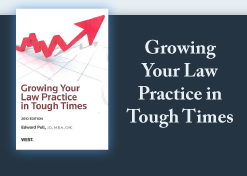|
What If You Lost Your
Largest Client?
UCLA's basketball legend John Wooden, who recently passed away just shy of his one hundredth birthday, was a "coach's coach." His great admonition, "Failing to plan is planning to fail," is a constant refrain in my own coaching advice. The important part of Coach Wooden's message is not that everything can be anticipated; rather, it's that, if you make no effort to anticipate at all, life will constantly come as a very unpleasant shock.
I frequently chide my wife for thinking of all the horribles that could befall us. I suggest that she should have been a law school professor, creating hypotheticals that cannot be resolved. Her response? You can't avoid the potholes in life without planning to do so – you can't create your plan for the good life without also thinking about what could go awry.
Apply this thinking to what too many law firms think cannot be planned – the amount and type of revenue they take in. A firm that does not decide what kind of practice it wants will wind up with one reflecting whatever walks in the door. It is doubtful that serendipity and whim are the best paths to success. A self-sustaining plan expresses in financial terms the firm's objectives and goals for the clients it wants, and the revenue it wants those clients to generate.
A statistical premise called the Pareto Principle holds that, over time, most results are produced by only a few causes, generally in a proportion of 80 to 20. When applied to law firms, this produces the conventional wisdom that 80% of a typical firm's revenue is produced by 20% of its clients – the large, heavy hitters. Every firm should know in exact detail the work done for its largest clients, how profitable that work is for the firm, and what opportunities exist to get more work.
That means you should be able to answer fundamental questions about the products and services, customers, financial health and employee demographics of any major client. If you can't, the client will soon realize and likely resent it. And you could lose a major revenue producer.
The loss of a large client is such a major risk that making sure no single client exceeds 10% of your total revenue may be wise. Too many firms focus on a very few, larger clients and are severely damaged when the fees from that client fail to continue – from dissatisfaction, change of billing attorney, merger, recession, or other unanticipated problems. Some firms believe that having numerous small clients leads to greater revenue stability.
However, studies suggest that small clients drain too many firm resources while providing too little profitability. Larger clients mean more revenue and more interesting challenges. But they must be balanced to assure that the firm is not at risk if some or even all should leave.
You may be willing to accept this risk for the short-term with the intent of getting more clients so that the percentage allocation to the "larger" client is reduced while maintaining the billings at the same level for the client. If so, make no long-term capital or other expenditures at the behest of larger clients without some type of assurance that their business will stay with you until at least the amortization for the new expenditure is completed.
Otherwise a long-term strategy based exclusively on fewer, larger clients will almost always lead to disaster.
|
|

Following the worst economic crisis since the Great
Depression, and facing a sea change in clients' demands
and expectations, law firms must respond and adapt
quickly and effectively. Law firms must choose the kind of
law practice they will be; the marketing and business
development tactics they will use; the overhead that is
critical to their functioning; how to price, bill and collect
for services; and how to manage the cash flow cycle.
Success lies in identifying and capturing the right kinds of
clients, providing the services those clients need in ways
that add value, and ensuring prompt payment and the
ability to grow profits. This book, based on the
experiences of Ed and his clients over 20 years of
coaching and consulting, provides the keys to
successfully thriving in the new era.
Now Available
Special New Release Price: $79
Regular Price: $120
Call or Order Online at:
1-800-837-5880
www.lawbiz.com





|

|
|
|

Personal Commentary
We are traveling along the Oregon and California coastline. Currently on Redwood
Highway. These redwoods are among the most incredible living things ever
seen by man! They are truly majestic. Talk with you next week.
Best wishes,
Ed Poll
lawbiz.com
lawbizblog.com
www.LawBizForum.com
800-837-5880
Please use the URL below to link to this issue:
www.lawbiz.com/nlimages/tip-7-13-10.html
|

|

What Readers Are Saying...
"No matter how you slice it, there is
no substitute for wisdom and
experience. Ed Poll has
demonstrated both in this eyeopening
book about the essential
elements of running a profitable law
practice. He provides practical
wisdom along with simple ways to
adopt and incorporate best practices
for each. After explaining the pros
and cons of every decision, he makes
recommendations and provides
useful guides disguised as key
principles. Buy the book so you too
can access Ed's wisdom and
experience. It's worth much more
than the investment."
STEWART L. LEVINE. ESQ.,
FOUNDER, RESOLUTIONWORKS
AUTHOR, GETTING TO RESOLUTION;
THE BOOK OF AGREEMENT AND
COLLABORATION 2.0
|

|

|






